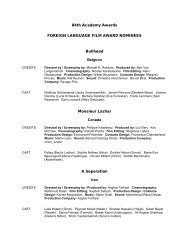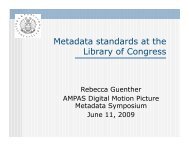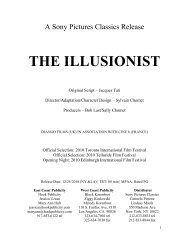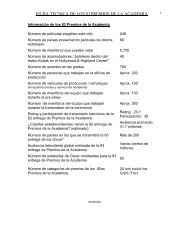Download Report - Academy of Motion Picture Arts and Sciences
Download Report - Academy of Motion Picture Arts and Sciences
Download Report - Academy of Motion Picture Arts and Sciences
You also want an ePaper? Increase the reach of your titles
YUMPU automatically turns print PDFs into web optimized ePapers that Google loves.
distance from the screen in the line <strong>of</strong> projection is<br />
<strong>of</strong> influence.<br />
One more subject remains {or consideration<br />
which, I underst<strong>and</strong>, has caused some uneasiness in<br />
cinematographic circles. There seems to be some<br />
belief <strong>and</strong> some fear that with Mazda lighting <strong>and</strong><br />
Panchromatic film the lenses now in use cannot be<br />
made to give satisfactory results, because, it is said,<br />
the best photographic focus does not coincide with<br />
the best visual focus. We shall first inquire into<br />
this on theoretical grounds <strong>and</strong> then report on such<br />
few controlled experiments as have been made to<br />
subject this matter to test.<br />
In No. 31 <strong>of</strong> the Transaction o{ Society o{ <strong>Motion</strong><br />
<strong>Picture</strong> Engineers, L. A. Jones published curves<br />
setting forth, graphically, data on the average radiation<br />
{rom Inc<strong>and</strong>escent Tungsten lamps <strong>of</strong> wattages<br />
such as are used in studio work, the transmission<br />
characteristics <strong>of</strong> a representative photographic objective,<br />
<strong>and</strong> the sensitivity curves <strong>of</strong> Orthochromatic<br />
<strong>and</strong> Panchromatic emulsions. The product for any<br />
given wave length leads to a quantity which Mr.<br />
Jones has called photicity.<br />
L<br />
b<br />
d<br />
9<br />
wavrlEncri<br />
Figures 7 <strong>and</strong> 2 show the results <strong>of</strong> multiplying<br />
together these three curves for the two kinds <strong>of</strong><br />
fift. They show the relative response <strong>of</strong> the emulsions<br />
to the various wave lengths emanating from<br />
Inc<strong>and</strong>escent Tungsten after allowing for the filtering<br />
effect <strong>of</strong> one <strong>of</strong> the st<strong>and</strong>ard photographic lenses.<br />
The two curves are not comparable, quantitatively,<br />
since some <strong>of</strong> the data on which they are based are<br />
not expressed in the same units in both cases. They<br />
serve, however, to show that both emulsions respond<br />
to all wave lengths without either <strong>of</strong> them falling<br />
to an insignificant value until a wave-length is<br />
reached corresponding to the orange region o{ the<br />
spectrum. In the blue, activity begins at wavelength<br />
330. Below this point, no matter how much<br />
radiation there might be within reason its effect<br />
would be insignificant because <strong>of</strong> the absorption <strong>of</strong><br />
the lens. The principal difference in the curves is,<br />
<strong>of</strong> course, the extension <strong>of</strong> sensitivity into the red<br />
displayed by the Panchromatic film.<br />
Any failure <strong>of</strong> visr,ral <strong>and</strong> photographic foci must<br />
depend upon the combination <strong>of</strong> values shown by the<br />
(mL,<br />
E<br />
E<br />
l<br />
WAve€ncrh<br />
FIGURE<br />
curves <strong>of</strong> Figures 1, <strong>and</strong> 2 <strong>and</strong> upon the condition<br />
<strong>of</strong> correction <strong>of</strong> chromatic aberration <strong>of</strong> the lens in<br />
question. Classical practice in correcting a lens {or<br />
chromatic aberration requires that the best focus<br />
Ior a wave length at about 4340 in the blue-violet<br />
region be united with the best focus for a wave<br />
length o{ about 5890 in the yellow, <strong>and</strong> that the<br />
focal lengths or magni{ying powers be practically<br />
equal for those two colors. With this practice agreed<br />
upon as st<strong>and</strong>ard there is room for some difierences<br />
in final correction because <strong>of</strong> the fact that exact<br />
coincidence in size <strong>and</strong> position <strong>of</strong> the violet <strong>and</strong><br />
yellow images is possible only for one zone <strong>of</strong> the<br />
lens. The outer zones <strong>of</strong> fast lenses cannot be<br />
given the same correction as the central zone <strong>and</strong> in<br />
the exact disposition <strong>of</strong> these residual aberrations<br />
there is some chance for differences in performance<br />
between different makes <strong>of</strong> lenses.<br />
Assuming, however, that the best focus for the<br />
two colors mentioned is coincident there remains a<br />
residual color aberration due to which the colors<br />
lying between the two chosen colors will come to<br />
focus somewhat nearer the lens <strong>and</strong> colors lying beyond<br />
the chosen wave-lengths will be united in focal<br />
points lying {arther from the lens than the normal<br />
focal point. This secondary spectrum, as it is called,<br />
might conceivably result in a shift <strong>of</strong> the apparently<br />
best photographic focus if it were large enough <strong>and</strong><br />
if the emulsion had sufficient selective effect. Panchromatic<br />
emulsion, however, appears to utilize the<br />
same range <strong>of</strong> wave-lengths as the Orthochromatic<br />
plus some greater sensitivity in the red. The actual<br />
secondary spectrum efiect in the range added to the<br />
efiective photographic radiation by the use <strong>of</strong> Panchromatic<br />
film is actually very small because <strong>of</strong> the<br />
low dispersion <strong>of</strong> glass for the long wave-lengths <strong>of</strong><br />
red light. It does not exceed a fourth <strong>of</strong> the region<br />
<strong>of</strong> uncertainty as to what constitutes the best visual<br />
focus <strong>and</strong> amounts to a very small part <strong>of</strong> the variation<br />
<strong>of</strong> Chromatic aberration between central <strong>and</strong><br />
marginal zones in anF:2.5 or F:2.0 lens.<br />
There is undoubtedly sufficient secondary spectrum<br />
in long focus lenses <strong>of</strong> low relative aperture<br />
to be detected photographically especially when<br />
using filters, but with the short focus high aperture<br />
II<br />
(mru)<br />
| \\ |<br />
L'"<br />
J
















